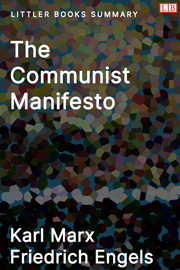Book Description
One of the world's most influential political documents.
If You Just Remember One Thing
History is driven by class struggle rooted in who controls the economy (the means of production). This leads to the exploitation of ... More
Bullet Point Summary and Quotes
- "A spectre is haunting Europe -- the spectre of communism." Politicians are labeling communists as enemies. It is a critical time for communists to speak up.
- The control of the economy directly influences the power dynamics within a society. The wealthy have the power and the poor are subjugated. This is why you never see poor people with political power.
- Changes in mode of production (how essentials like food and shelter are produced) trigger shifts in society.
- In the past, hunter-gatherer societies had minimal class distinctions since individuals could only provide for their immediate communities.
- The introduction of farming revolutionized food production, leading to an abundance that could be sold. Consequently, a hierarchy formed between those who controlled the food supply and those who had to work for them, establishing the first class system where economic power equated to political power.
- Throughout history, societies have developed intricate hierarchies based on conflicting classes. The division between these classes stems from their varying control over the modes of production. The dominant class exploits its position to subjugate others and wield authority over society's wealth.
- Roman slaves were denied property ownership to ensure their oppression.
- Feudal serfs were bound to their land, indebted to wealthy landowners who effectively owned them and compelled them to work.
- The class struggle, the struggle between oppressor and oppressed classes, is key to shaping history.
- In feudalism, the royalty and church owned the land, which was the main means of production. However, the advent of industrialization in the 18th century provided factory work as an alternative form of labor, and feudalism began to disappear.
- The shift to industrialization did not reduce oppression or change the hierarchy. Workers sold their labor for wages that did not match the value they produced. The surplus capital accrued went to the bourgeoisie (those who own the industrial means of production), bolstering their power.
- The pursuit of more capital leads to exploitation and global expansion, making capitalism the prevailing economic system today.
- The proletariat (the working class) do not work for themselves, but for factory owners who pay them only enough to survive, solely to ensure their continued productivity and the growth of the factories. The vast majority of rewards from their work goes to the bourgeoisie.
- Workers have become utilitarian commodities, their lives tied to finding work, and their value diminishes once their labor no longer contributes to the bourgeoisie's wealth accumulation.
- As the division of labor intensifies, proletariat work becomes more replaceable and monotonous. The proletariat are now disconnected from their individuality and reduced to mere cogs in the capitalist machine.
- Workers are now showing more unity and challenging the bourgeoisie. The bourgeoisie's exploitations will result in their own demise.
- Communists aim to unite workers globally to topple the bourgeoisie. The abolition of private property is a key component of this plan, as it serves as the foundation of bourgeois dominance over the proletariat.
- Capital and profits should not only be held by the people at the top, they are products of the entire society and should be collectively shared.
- There are demands that must be met to achieve progress, including a progressive income tax; abolition of inheritances, private property, and child labour; free public education; nationalisation of credit and the means of transport and communication; removal of regional borders; and expansion of publicly owned and unused land for agriculture.
- Communism is different from other forms of socialist doctrine in that the others advocate reformism (reforming an existing institution instead of its abolition and replacement) instead of a revolution by the working class.
The Communist Manifesto: Resources
- Download this summary and 173+ other top nonfiction book summaries in one book (PDF, eBook, DOCX)
- Buy the book
